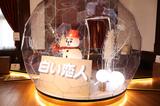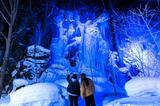この記事では、東京都内のあじさいの名所を探している人に向けて、おすすめスポット15カ所をご紹介。それぞれの場所で楽しめる絶景ポイントや撮影スポット、あじさいの見頃、周辺情報にも注目しながら厳選しました。今年の梅雨は、雨の日が楽しみになる、あじさい散歩に出かけてみませんか?
白山神社・白山公園【文京区】
境内も公園もあじさい一色に染まる花の名所

東京・文京区にある白山神社と白山公園は、毎年6月に見頃を迎えるあじさいの名所として全国的にも知られるスポット。境内と隣接する公園をあわせると、約3,000株ものあじさいが咲き誇り、まさに梅雨時期ならではの風景が広がります。
由緒ある神社として知られる白山神社は、948年創建、縁結びの神様としても信仰を集める東京十社の一社。そんな歴史ある境内のいたるところに色とりどりのあじさいが咲き、あじさい越しに見る拝殿は、静かで情緒あふれる一枚が撮れると、カメラ好きにも人気です。
また、境内と公園の間にある富士塚もこの時期だけ特別に一般開放され、ここにも見事なあじさいが咲き揃います。

例年6月には「文京あじさいまつり」が開催され、地域の風物詩として賑わいを見せるのも魅力のひとつ。2025年も6月7日から6月15日まで開催されており、あじさいとともに楽しむ神社散策は、都会の喧騒を忘れさせてくれるひとときとなるでしょう。
白山神社・白山公園
高幡不動尊金剛寺【日野市】
五重塔とあじさいが美しい多摩エリアの名所
日野市にある高幡不動尊金剛寺(高幡山明王院金剛寺)は、真言宗智山派の別格本山で、古くから「関東三大不動」のひとつに数えられる格式ある寺院。新選組副長・土方歳三の菩提寺としても知られ、歴史と文化が色濃く息づく場所です。
初夏になると境内は、約250種類・7,800株以上のあじさいに包まれ、あじさい一色の景観が広がります。6月1日から6月30日に開催される「あじさいまつり」では、五重塔を背景に咲くあじさいや、散策路沿いの花々、山林に広がる山あじさい園など、見どころが満載です。
特に、あじさい越しに見る五重塔はフォトジェニックな定番スポット。また、石段の両脇にもあじさいが咲き誇り、情緒豊かな風景が楽しめます。まつり期間中は「山内八十八ケ所クイズめぐり」や「植木市」「写真コンクール」などのイベントも多く開催され、家族連れや写真愛好家にも人気です。
寺院散策とともに静かで色鮮やかな“あじさいの時間”を過ごせる、東京・多摩エリア屈指のあじさい名所です。
高幡不動尊金剛寺
| 見頃 | : | 5月下旬〜6月下旬 |
|---|---|---|
| 住所 | : | 東京都日野市高幡733 |
| 電話 | : | 042-591-0032 |
| アクセス | : | 京王線・多摩都市モノレール「高幡不動駅」より徒歩約5分 |
| web | : | 高幡不動尊金剛寺 公式サイト |
国営昭和記念公園【立川市】
約9,000株のあじさいが咲く大型公園
東京都立川市・昭島市にまたがる国営昭和記念公園は、四季折々の自然が楽しめる人気の大型公園。東京のあじさい名所の中でも、50種類以上という多彩な品種の豊富さと広々とした景観が魅力です。

園内には約9,000株のあじさいが植栽されており、特に見頃となる6月中旬には「あじさいロード(ふれあい広場北側斜面〜花木園展示棟周辺)」が見どころ。セイヨウアジサイ、ガクアジサイ、アナベルなどが織りなす彩り豊かな風景が広がります。

さらに園内では、「紫陽花さんぽ」が開催され、あじさい傘の貸し出しやフォトスポットなど、写真映えする体験ができることも。また、多摩のあじさいの名所5カ所合同で行われる「東京・多摩の紫陽花めぐり」を紹介する写真展を行うなど、あじさい鑑賞をより特別な思い出にしてくれます。
自然の中をゆったり散策して、東京にいながら贅沢な“あじさい時間”を楽しみたい人におすすめのスポットです。
国営昭和記念公園
| 見頃 | : | 6月上旬~7月上旬 |
|---|---|---|
| 住所 | : | 東京都立川市緑町3173 |
| 電話 | : | 042-528-1751 |
| 料金 | : | 日により異なる |
| アクセス | : | JR中央線「立川駅」より徒歩約10分 青梅線「西立川駅」より徒歩約2分 |
| web | : | 国営昭和記念公園 公式サイト |
浜離宮恩賜庭園【中央区】
潮風と歴史とともに多彩なあじさいを愛でる

東京都中央区に位置する浜離宮恩賜庭園は、徳川将軍家ゆかりの江戸を代表する大名庭園。25haを超える広大な敷地は都内最大級で、特別名勝・特別史跡の二重指定を受ける貴重な文化財でもあります。
あじさいの見頃は5月中旬〜6月中旬頃。園内ではヤマアジサイ、ガクアジサイ、ホンアジサイ、カシワバアジサイなど、約140株のあじさいが咲き揃います。なかでも、海から水を引き込んだ大名庭園「潮入の池」に架かる総檜造りの「お伝い橋」からの眺めは格別の美しさ。池と島々、そしてあじさいの共演が楽しめる、フォトスポットとしてもおすすめの風景です。

また、土日祝限定で抹茶を楽しめる「松の御茶屋」では、あじさいを浮かべた花手水の演出が見られることも。都会の真ん中にありながら、静けさと季節の美しさを堪能できる庭園として、幅広い世代に親しまれています。
浜離宮恩賜庭園
| 見頃 | : | 5月中旬〜6月下旬 |
|---|---|---|
| 住所 | : | 東京都中央区浜離宮庭園1-1 |
| 電話 | : | 03-3541-0200 |
| 料金 | : | 一般300円、65歳以上150円、小学生以下・都内在住・在学の中学生は無料 |
| アクセス | : | 〈大手門口〉 都営地下鉄大江戸線「築地市場駅」「汐留駅」・ゆりかもめ「汐留駅」より徒歩約7分 JR・東京メトロ銀座線・都営地下鉄浅草線「新橋駅」より徒歩約12分 〈中の御門口〉 都営地下鉄大江戸線「汐留駅」より徒歩約5分 JR「浜松町駅」より徒歩約15分 |
| web | : | 浜離宮恩賜庭園 公式サイト(東京都公園協会サイト内) |
上野恩賜公園【台東区】
池とあじさい、歴史とアートに囲まれ癒される

iStock.com/Jonathan W. Cohen
東京・台東区に広がる上野恩賜公園は、博物館や動物園、美術館が集まる文化エリアとして知られる一方で、季節の花々を楽しめる自然豊かな公園でもあります。中でもあじさいの季節には、歴史的な建物と花のコントラストが楽しめる貴重なスポットに。
園内でのあじさいの見どころは、なんといっても不忍池の西側一帯。池をぐるりと囲むように咲く色とりどりの花々は、水辺の風景に鮮やかな彩りを添えてくれます。さらに、弁天堂へと続く遊歩道にもあじさいが植えられており、池のほとりを歩きながらゆっくりと楽しむ散策コースとしてもおすすめです。

iStock.com/ranmaru_
また、ボートに乗りながら眺めるあじさいは格別の風情。園内の花園稲荷神社では、鳥居のトンネルとあじさいの共演が楽しめるスポットとしても注目を集めており、他の名所とは一味違った幻想的な風景が広がります。
文化と自然、そして季節の彩りがバランスよく楽しめる東京屈指のあじさい散策スポットです。
上野恩賜公園
| 見頃 | : | 6月中旬〜7月上旬 |
|---|---|---|
| 住所 | : | 東京都台東区上野公園・池之端3 |
| 電話 | : | 03-3828-5644 |
| 料金 | : | 一部有料施設あり |
| アクセス | : | JR山手線・JR京浜東北線・JR高崎線・JR宇都宮線・東京メトロ銀座線・東京メトロ日比谷線「上野駅」より徒歩2分 京成本線「京成上野駅」より徒歩1分 |
| web | : | 上野恩賜公園 公式サイト |
隅田公園【台東区】
スカイツリーを望むあじさいロードが魅力

隅田川沿いに南北に長く広がる隅田公園は、台東区側と墨田区側の両岸にまたがる開放感あふれる都心のリバーサイドパーク。東京都内に3カ所しかない復興大公園のひとつとして整備され、春の桜だけでなく、初夏には一面のあじさいが訪れる人を出迎えてくれます。
見どころは、台東区側にある約2kmにわたる「あじさいロード」。6月になると、ホンアジサイやアナベル、スミダノハナビ、ウズアジサイなど約10,000株のあじさいが一斉に咲き誇り、水辺の散策路を華やかに彩ります。

東京スカイツリーを背景にした景観は、この公園ならではの絶景。園内では地域と協力しながらあじさいの剪定や整備も行われており、“名所づくり”が日々進んでいるのも魅力です。
川風を感じながら色とりどりのあじさいを楽しんだあとは、すぐ近くの浅草エリアで観光やグルメを楽しむのもおすすめのコース。お散歩感覚で訪れられる、都会の癒しスポットです。
隅田公園
| 見頃 | : | 6月上旬〜7月下旬 |
|---|---|---|
| 住所 | : | 東京都台東区花川戸1 |
| 電話 | : | 東京都台東区花川戸1 |
| アクセス | : | 東京メトロ銀座線「浅草駅」より徒歩約5分 東武伊勢崎線「浅草駅」より徒歩約5分 都営地下鉄浅草線「浅草駅」より徒歩約7分 |
| web | : | 隅田公園 公式サイト |
向島百花園【墨田区】
江戸情緒あふれる庭園で出合う“墨田の花火”

江戸時代、町人文化が花開いた文化・文政期に開園した向島百花園。骨とう商を営んでいた佐原鞠塢(さはら きくう)が文化人たちとともに作り上げた、草花鑑賞を楽しむことを目的とした民営の庭園です。風情ある景観が今なお残り、四季折々の草花とともに江戸の美意識を体感できる貴重なスポットです。
6月になると、園内ではさまざまな品種のあじさいが咲き始め、とりわけ人気なのが「墨田の花火」というガクアジサイ。

小さな青い両性花の周りに白い装飾花が花火のように広がるその姿は、まさに初夏を代表する風物詩。池のほとりや茶屋跡など、趣のあるロケーションに点在するあじさいたちは、静けさの中に凛とした美しさを漂わせます。
園内ではホンアジサイ、ヤマアジサイ、ガクアジサイなども咲き揃い、入園者にはあじさいの品種と咲いている場所を記した「あじさい配置図」も配布。落ち着いた雰囲気のなかで、あじさいをじっくり味わえる“大人の花散歩”にふさわしいスポットです。
向島百花園
| 住所 | : | 5月下旬~6月中旬 |
|---|---|---|
| 住所 | : | 東京都墨田区東向島3-18-3 |
| 電話 | : | 03-3611-8705 |
| 料金 | : | 一般150円、65歳以上70円、小学生以下及び都内在住・在学の中学生は無料 |
| アクセス | : | 東武スカイツリーライン「東向島駅」より徒歩約8分 京成電鉄押上線「京成曳舟駅」より徒歩約13分 |
| web | : | 向島百花園 公式サイト(東京都公園協会サイト内) |
小岩菖蒲園【江戸川区】
ハナショウブとあじさい、電車の絶景が楽しめる
江戸川の河川敷に広がる小岩菖蒲園は、都内にいながら自然の風景を気軽に楽しめる、隠れた初夏の花の名所。地元の方から寄贈されたハナショウブをもとに、回遊式の庭園として整備された園内では、例年6月になると約50,000本のハナショウブと約2,000株のあじさいが同時に咲き揃い、訪れる人々の目を楽しませてくれます。

園内の見どころのひとつが、すぐ近くを通る江戸川橋梁とその上を走る電車の姿。特に人気なのは、あじさいの向こうにふいに姿を現す京成スカイライナーのスタイリッシュなフォルム。花と鉄道を一緒に写真に収めたい鉄道ファンやカメラ好きにとっても、絶好の撮影スポットです。

ハナショウブとあじさい、そして開放感ある空と河川敷の風景。毎年6月上旬には「小岩菖蒲園まつり」も開催され、地元の模擬店やステージイベントなどがにぎやかに開催されるのも、この時期ならではの楽しみです。家族連れやのんびりとしたお散歩にもぴったりの癒しの空間です。
小岩菖蒲園
| 見頃 | : | 6月上旬〜6月下旬 |
|---|---|---|
| 住所 | : | 東京都江戸川区小岩4 |
| 電話 | : | 03-5662-5543(みどりサービスセンター) |
| アクセス | : | 京成本線「江戸川駅」より徒歩約5分 |
| web | : | 小岩菖蒲園 公式サイト |
飛鳥山公園【北区】
線路沿いを彩る飛鳥山のさんぽ道

江戸時代、八代将軍・徳川吉宗が庶民のために整備した行楽地として知られる飛鳥山公園は、1873年に日本初の公園のひとつとして指定された、歴史と文化が息づく都内有数の緑地。園内には博物館や渋沢栄一旧邸「渋沢庭園」もあり、花と歴史の両方を楽しめるスポットです。

初夏になると見頃を迎えるのが、公園とJR線路の間に続く散歩道「飛鳥の小径(こみち)」。全長約1.3kmの小道には、アジサイやガクアジサイ、アナベルなど約10種類、1,300〜2,000株が咲き誇り、道行く人を鮮やかなグラデーションで包み込みます。2023年にはJR王子駅前の小径入り口に新たに750株が植栽され、さらに華やかさが増しました。
色とりどりの花々と、歴史的文化財をめぐる散歩は、日常に小さな特別感を添えてくれます。小道はやや狭いため、写真撮影や鑑賞の際は周りへの配慮を忘れずに楽しみましょう。
飛鳥山公園
| 見頃 | : | 6月上旬〜7月上旬 |
|---|---|---|
| 住所 | : | 東京都北区王子1-1-3 |
| 電話 | : | 03-5980-9210(飛鳥山公園管理事務所) |
| アクセス | : | JR京浜東北線「王子駅」より徒歩すぐ |
| web | : | 飛鳥山公園 公式サイト |
旧芝離宮恩賜庭園【港区】
静けさに映えるガクアジサイに風情を感じる
浜松町駅すぐそばという都心の立地にありながら、江戸の風情を今に残す回遊式泉水庭園「旧芝離宮恩賜庭園」。小石川後楽園と並び、現存する数少ない江戸初期の大名庭園として知られています。池を中心に据えた庭園構造や、石組みの美しさは当時の造園技術の粋を感じられる貴重な名勝です。
園内では、日本古来のガクアジサイを見ることができます。園路の脇や池の岸辺などに、控えめにたたずむように静かに咲いているのがこの庭園らしい魅力。濃い緑に囲まれた中に淡く浮かぶあじさいの姿は、しっとりとした季節感を際立たせてくれます。

静けさや余白を楽しむ“和の美”を感じられるあじさい鑑賞スポットとして、落ち着いた時間を過ごしたい方におすすめです。
旧芝離宮恩賜庭園
| 見頃 | : | 6月上旬〜6月下旬 |
|---|---|---|
| 住所 | : | 東京都港区海岸1-4-1 |
| 電話 | : | 03-3434-4029 |
| 料金 | : | 一般150円、65歳以上70円、小学生以下及び都内在住・在学の中学生は無料 |
| アクセス | : | JR山手線・京浜東北線「浜松町駅」より徒歩約1分 都営地下鉄大江戸線「大門駅」より徒歩約3分 都営地下鉄浅草線「大門駅」徒歩約3分 ゆりかもめ「竹芝駅」より徒歩約10分 |
| web | : | 旧芝離宮恩賜庭園 公式サイト(東京都公園協会サイト内) |
シンボルプロムナード公園【江東区】
白と青のあじさいが誘う、海辺の公園
《写真提供》東京港埠頭(株)
臨海副都心の青海・有明・台場エリアをつなぐ広大な緑地帯、シンボルプロムナード公園。花と緑、水辺の景観に囲まれながら、都市空間の中に開放感あふれるリラックスエリアが広がるこの公園は、散策にも写真撮影にもぴったりな、都心の癒しスポットです。
6月に入ると、園内各所に紫や青、白など色とりどりのあじさいが咲き誇り、街なかをやさしく彩ります。主な鑑賞エリアは、東京テレポート駅付近の「出会い橋」や「生きものの谷」エリア。なかでも注目は、両側に白いあじさいが咲き並ぶ“あじさいの階段”。その幻想的な光景は、ロマンチックでフォトジェニックな写真が撮れるとSNSでも話題です。

《写真提供》東京港埠頭(株)
歩道も広く、ベンチや水辺も多いので、のんびり過ごしたい休日や夕暮れ時のお散歩にも。あじさいを楽しみながら、お台場エリアの海の景色も一緒に堪能できるのも、この公園ならではの魅力です。
シンボルプロムナード公園
| 見頃 | : | 6月上旬〜6月下旬 |
|---|---|---|
| 住所 | : | 東京都港区台場1・2、東京都江東区青海1・2、東京都江東区有明2・3 |
| 電話 | : | 03-5531-0852 |
| アクセス | : | りんかい線「東京テレポート駅」より生きものの谷 徒歩約3分 ゆりかもめ「お台場海浜公園駅」より生きものの谷 徒歩約8分 |
| web | : | シンボルプロムナード公園 公式サイト |
府中市郷土の森博物館【府中市】
昔懐かしい風景とともに楽しむあじさいたち
東京都府中市にある郷土の森博物館は、広さ約14万平方メートルもの敷地に、自然や地形、歴史を再現した“屋外型の総合博物館”。江戸〜昭和初期に建てられた町屋や農家、小学校などの建築物を移築・復元し、ふるさとの記憶を体感しながら学べる施設です。

6月中旬になると、園内の各所に30種・約10,000株のあじさいが咲き誇り、まるで花の森のような風景が広がります。見どころは、「あじさいの丘」「アナベルの丘」「あじさいの小径」「アナベルの小径」など、それぞれ表情の異なる散策スポット。ガクアジサイやアナベル、セイヨウアジサイなど、多彩な品種が楽しめます。
特におすすめなのが、古民家や木造校舎の周りに咲くあじさいの風景。どこか懐かしく、情緒あるその光景は、写真映えするだけでなく、心に残る初夏の思い出になるはず。

また2025年は、5月31日(土)〜7月6日(日)に「郷土の森あじさいまつり」を開催。期間中は本館前にさまざまな品種の鉢植えあじさいが勢ぞろいし、広島県府中市から寄贈された特別なあじさいも展示される予定です。
府中市郷土の森博物館
| 見頃 | : | 5月下旬〜7月上旬 |
|---|---|---|
| 住所 | : | 東京都府中市南町6-32 |
| 電話 | : | 042-368-7921 |
| 料金 | : | 大人300円、中学生以下150円(博物館利用のみ) |
| アクセス | : | JR武蔵野線・南武線「府中本町駅」より徒歩約20分 京王線・JR南武線「分倍河原駅」より徒歩約20分 西武多摩川線「是政駅」より徒歩約20分 |
| web | : | 府中市郷土の森博物館 公式サイト |
わんダフルネイチャーヴィレッジ【あきる野市】
愛犬とともに楽しめる圧巻のあじさいエリア

東京都・あきる野市、東京サマーランドに隣接するわんダフルネイチャーヴィレッジは、愛犬と一緒に自然を楽しめるアウトドア複合施設。ドッグランやドッグプール、バーベキュー場、カフェ、キャンプサイトなどが揃い、都心から少し足をのばせば“犬連れの楽園”ともいえるスポットです。
ここで見られるあじさいの名所は、約3万平方メートルに広がる都内最大級のあじさいエリア。見どころはなんといっても、約3,000株のアナベルが山の斜面を真っ白に染め上げる「アナベルの雪山」。6月中旬〜7月初旬にかけて見頃を迎え、その圧巻の光景は一度見たら忘れられない美しさです。その他にも約60種・15,000株のあじさいが咲き誇り、品種の多さも魅力です。

あじさいエリアはハイキングコースに沿って広がっており、山頂からは秋川渓谷を見渡せる絶景ポイントも。自然の空気に包まれながら、愛犬とともにあじさいを楽しめる、他にはない特別な時間を過ごせます。
わんダフルネイチャーヴィレッジ
| 見頃 | : | 6月中旬〜7月上旬 |
|---|---|---|
| 住所 | : | 東京都あきる野市上代継600 |
| 電話 | : | 042-558-6511 |
| 料金 | : | おとな(中学生以上)850円、こども(小学生以下)無料、犬850円(2頭目以降450円) ※犬2頭目以降の割引は、1頭目と同じ飼い主様の犬にのみ適用します。 |
| アクセス | : | 京王線・JR中央線「八王子駅」よりバスで約30~35分 JR五日市線「秋川駅」よりバスで約10分 |
| web | : | わんダフルネイチャーヴィレッジ 公式サイト |
薬師池公園【町田市】
歴史ある公園で楽しむ豊かなあじさい風景

町田市を代表する景勝地として知られる薬師池公園は、「新東京百景」「東京都指定名勝」「日本の歴史公園100選」にも選ばれている、歴史と自然が調和した美しい公園。園内中央にある大きな池を囲むように、ウメやツバキ、サクラ、ハナショウブ、オオガハスなど四季折々の花が楽しめ、年間を通じて多くの来園者でにぎわいます。
6月中旬から7月上旬にかけては、園内で42品種・約1,000株のガクアジサイやセイヨウアジサイが見頃を迎え、青・紫・ピンクなどの花が園路を華やかに彩ります。

またこの時期には、「しょうぶ・あじさいまつり」が開催され、園内はよりいっそうにぎやかな雰囲気に包まれます。さらに、徒歩圏内にある「えびね苑」でも約5,000株のあじさいが公開期間限定で楽しめるため、あじさい散策の目的地としておすすめです。古きよき景観と花々が調和する薬師池公園で、静かに咲くあじさいをゆっくりと楽しんでみてはいかがでしょうか。
薬師池公園
| 見頃 | : | 6月中旬〜7月上旬 |
|---|---|---|
| 住所 | : | 東京都町田市野津田町3270 |
| 電話 | : | 042-724-4399 |
| アクセス | : | 小田急「町田駅」北口(POPビル先)21番乗り場から本町田経由鶴川行き、 または本町田経由野津田車庫行きバスで「薬師池」か「薬師ヶ丘」停留所下車 |
| web | : | 薬師池公園 公式サイト |
あじさい公園【小平市】
町とともに蘇った、小さなあじさい名所

東京都・小平市にあるあじさい公園は、1973年にあじさいの名所をめざして整備された、地域密着型の癒しスポット。陽当たりを好むあじさいにとっては、周囲の樹木が生い茂ったことで一時全滅の危機に直面しましたが、1996〜1997年にかけての環境整備によって見事に復活。地域とともに育まれた“蘇りのあじさいスポット”です。
見頃を迎える6月中旬から下旬には、約1,500株のガクアジサイ、セイヨウアジサイ、カシワバアジサイなどが、園内をやさしく彩ります。公園の規模は大きくないものの、木陰とあじさいの織りなす静かな雰囲気が魅力で、狭山・境緑道の散策途中の休憩スポットとしても人気。

また、見頃の時期には、剪定体験や挿木講習会など、あじさいに親しむイベントも開催されており、地域の人たちが自然と触れ合える場として親しまれています。
あじさい公園
| 見頃 | : | 6月中旬〜7月中旬 |
|---|---|---|
| 住所 | : | 東京都小平市美園町1-25-23 |
| 電話 | : | 042-346-9556 |
| アクセス | : | 西武新宿線「小平駅」より徒歩約5分 |
| web | : | あじさい公園 公式サイト |
東京のあじさい名所で、梅雨の風景を彩り豊かに楽しもう
東京には、神社や公園、庭園などあじさいが美しく咲き誇る名所が点在しています。品種や景観もさまざまで、散策や写真撮影にもおすすめです。見頃の時期にあわせて、お気に入りのスポットを訪れてみてはいかがでしょうか。
掲載の内容は記事公開時点のもので、変更される場合があります。
















